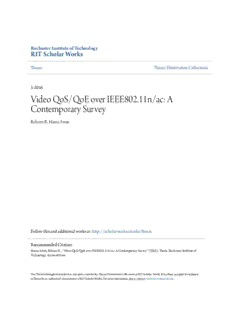
Rebeen R. Hama Amin PDF
Preview Rebeen R. Hama Amin
RRoocchheesstteerr IInnssttiittuuttee ooff TTeecchhnnoollooggyy RRIITT SScchhoollaarr WWoorrkkss Theses 5-2016 VViiddeeoo QQooSS//QQooEE oovveerr IIEEEEEE880022..1111nn//aacc:: AA CCoonntteemmppoorraarryy SSuurrvveeyy Rebeen R. Hama Amin Follow this and additional works at: https://scholarworks.rit.edu/theses RReeccoommmmeennddeedd CCiittaattiioonn Hama Amin, Rebeen R., "Video QoS/QoE over IEEE802.11n/ac: A Contemporary Survey" (2016). Thesis. Rochester Institute of Technology. Accessed from This Thesis is brought to you for free and open access by RIT Scholar Works. It has been accepted for inclusion in Theses by an authorized administrator of RIT Scholar Works. For more information, please contact [email protected]. Video QoS/QoE over IEEE802.11n/ac: A Contemporary Survey By Rebeen R. Hama Amin Thesis submitted in partial fulfillment of the requirements for the Degree of Master of Science in Networking and System Administration Rochester Institute of Technology B. Thomas Golisano College of Computing and Information Sciences Department of Information Sciences and Technologies May 2016 I Rochester Institute of Technology B. Thomas Golisano College of Computing and Information Sciences Master of Science in Networking and System Administration ~ Thesis Approval Form ~ Student Name: Rebeen R. Hama Amin Thesis Title: Video QoS/QoE over IEEE802.11n/ac: A Contemporary Survey Thesis Area(s): Networking ~ MS Thesis Committee ~ Name Signature Date Prof. Bruce Hartpence Chair Prof. Charles Border Committee Member Prof. Sylvia Perez-Hardy Committee Member II DEDICATION I dedicate this thesis to my parents (Kazhal and Rebwar) for their support and encouragement. To professor (Bruce Hartpence) for his support and guidance through the entire process. To my friends at RIT, especially (Swagata D. Chaudhury) for her help and support. I ACKNOWLEDGEMENT I would like to express my gratitude and appreciation to the Fulbright program for accepting me as a Fulbrighter and giving me this scholarship to finish my master degree at R.I.T. I also want to thank R.I.T for accepting me as a graduate student and realize my dream. Finally, I would like to highly appreciate professors in my thesis committee (Prof. Bruce Hartpence, Prof. Charlies Border and Prof. Sylvia Perez- Hardy). II ABSTRACT Video QoS/QoE over IEEE802.11n/ac: A Contemporary Survey By Rebeen R. Hama Amin The demand for video applications over wireless networks has tremendously increased, and IEEE 802.11 standards have provided higher support for video transmission. However, providing Quality of Service (QoS) and Quality of Experience (QoE) for video over WLAN is still a challenge due to the error sensitivity of compressed video and dynamic channels. This thesis presents a contemporary survey study on video QoS/QoE over WLAN issues and solutions. The objective of the study is to provide an overview of the issues by conducting a background study on the video codecs and their features and characteristics, followed by studying QoS and QoE support in IEEE 802.11 standards. Since IEEE 802.11n is the current standard that is mostly deployed worldwide and IEEE 802.11ac is the upcoming standard, this survey study aims to investigate the most recent video QoS/QoE solutions based on these two standards. The solutions are divided into two broad categories, academic solutions, and vendor solutions. Academic solutions are mostly based on three main layers, namely Application, Media Access Control (MAC) and Physical (PHY) which are further divided into two major categories, single-layer solutions, and cross-layer solutions. Single-layer solutions are those which focus on a single layer to enhance the video transmission performance over WLAN. Cross-layer solutions involve two or more layers to provide a single QoS solution for video over WLAN. This thesis has also presented and technically analyzed QoS solutions by three popular vendors. This thesis concludes that single-layer solutions are not directly related to video QoS/QoE, and cross-layer solutions are performing better than single-layer solutions, but they are much more complicated and not easy to be implemented. Most vendors rely on their network infrastructure to provide QoS for multimedia applications. They have their techniques and mechanisms, but the concept of providing QoS/QoE for video is almost the same because they are using the same standards and rely on Wi- Fi Multimedia (WMM) to provide QoS. III TABLE OF CONTENT 1. INTRODUCTION ………………………………………………………………………………....1 1.2. Problem Statement…………………………………………………………..…………………2 2. RELATED WORKS…………………………………………………………………………….....3 3. VIDEO OVER WIRELESS OVERVIEW………………………………………………………....4 3.1. Video Codecs.......................................................................................................................…...4 3.1.1. H.263……………….……………………………….….……………………………….5 3.1.2. H.264/AVC………………….………………………...…...…………………………...6 3.1.2.1. Network Abstraction Layer………….…………………....……………………6 3.1.2.2. Video Coding Layer………………................……………….………………...9 3.1.3. H.265/HEVC…………………………………………………….………..…………...12 3.1.3.1. HEVC Characteristics and Features………………………….………..………12 3.1.4. VP8………………………………………..…………………………………………...16 3.1.4.1. VP8 Technical Features……….……………………………………................16 3.2. IEEE 802.11n………………………………………………………………………………...18 3.2.1. PHY……………………………………………..……………….…………………….18 3.2.2. MAC………………………………………………..………………….………………18 3.3. IEEE 802.11ac……………………………………………………………………….……….20 3.3.1. PHY………………………………………..…………………………………………..20 3.3.2. MAC…………………………………………..……………………………………….21 4. QOS/QOE SUPPORT IN IEEE 802.11N/AC……………………………………………………….23 4.1. QoS Overview………………………………………………………………………………..23 4.1.1. Resource Allocation……………………………..………………………………….…23 4.1.1.1. IntServ………………………………………….…………………………..…23 4.1.1.2. DifServ………………………………………………….………………….…24 IV 4.1.2. Service differentiation…………………………..………………………………….….24 4.1.3. Admission Control……………………………...……………………………...............24 4.1.4. Congestion Control…………………………………..………………………………...24 4.1.5. Scheduling………………………………………………..…………………................25 4.1.6. Traffic Shaping and Engineering……………………………..…………………….….25 4.2. QoS support in IEEE 802.11n/ac……………………………………………………….…….25 4.2.1. MAC layer QoS features………………………..……………………………...............25 4.2.1.1. Differentiated Services……………………….…………………………….…26 4.2.1.1.1. DCF………………………………….…………………………..…26 4.2.1.1.2. PCF………………………………………..……………………..…27 4.2.1.2. Priority Queuing………………………………………………….…..27 4.2.1.3. Scheduling…………………………………………………................28 4.2.1.4. Traffic Shaping…………………………………………………….…28 4.3. QoE Overview………………………………………………………………………………..28 4.3.1. QoE Measurement………………………………………..…………………................29 4.3.1.1. Subjective Assessment………………………………….………………….…29 4.3.1.2. Objective Assessment…………………………………………..……………..29 4.3.1.3. Hybrid Assessment………………………………………………….………...29 4.3.2 QoE Metrics……………………………………………………………………...….….29 4.3.2.1. Direct Metrics…………………………….………………………………...…30 4.3.2.2. Indirect Metrics………………………………….…………………................31 5. PROPOSED SOLUTIONS………………………………………………………………………….32 5.1. Academic Solutions…………………………………………………………………………..32 5.1.1. Single-Layer Solutions………..……………………………………………………….32 5.1.1.1. Application Layer Solutions………….……………………………………….32 5.1.1.2. MAC Layer Solutions………………………..………………………………..37 V 5.1.1.3. PHY Layer Solutions…………………………………….……………………40 5.1.2. Cross-Layer Solutions………………..………………………………………………..42 5.1.2.1. Application-PHY Solutions……………………….…………………………..42 5.1.2.2. Application-MAC Solutions……………………………..……………………44 5.1.2.3. MAC-PHY Solutions……………….………………………………………...47 5.1.2.4. Application-MAC-PHY Solutions……………….……………………….......48 5.2. Vendor Solutions……………………………………………………………………………..50 5.2.1. Aruba Infrastructure………………………..………………………………………….54 5.2.2. Cisco Infrastructure…………………………….……………….……………………..56 5.2.3. Ruckus Infrastructure………………………………..……………………………...…58 6. FINDINGS AND OPEN RESEARCH ISSUES………………………………………………........60 7. CONCLUSION AND FUTURE WORKS…………………………………………………………63 BIBLIOGRAPHY…………………………………………………………………………………….65 VI LIST OF TABLES Table 3.1. A comparison between 802.11n and 802.11ac………………………………………………….22 Table 4.1. MOS……………………………………………………………………………………………30 Table 4.2. PSNR to MOS…………………………………………………………………………………..31 VII
Description: